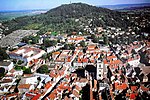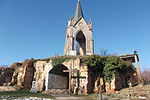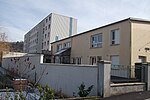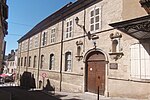Synagogue of Vesoul
19th-century synagogues in FranceAshkenazi Jewish culture in FranceAshkenazi synagoguesEuropean synagogue stubsFormer synagogues in France ... and 6 more
French religious building and structure stubsInfobox religious building with unknown affiliationMonuments historiques of Haute-SaôneSynagogues completed in 1875Use mdy dates from June 2024Vesoul

The Synagogue of Vesoul (French: Synagogue de Vesoul) is a former Jewish congregation and synagogue, located at 11 rue du Moulin-des-Prés, in the city of Vesoul, in Haute-Saône department of the Bourgogne-Franche-Comté region of France. Whilst active, the congregation worshipped in the Ashkenazi rite. The synagogue was listed as a monument historique on December 5, 1984. The building was erected in 1875 and classified as a monument historique in 1984. In 2011 the organization that owned the building, Les Restos du Coeur, decided to sell it.
Excerpt from the Wikipedia article Synagogue of Vesoul (License: CC BY-SA 3.0, Authors, Images).Synagogue of Vesoul
Impasse Fleurier, Vesoul
Geographical coordinates (GPS) Address Nearby Places Show on map
Geographical coordinates (GPS)
| Latitude | Longitude |
|---|---|
| N 47.621111111111 ° | E 6.1572222222222 ° |
Address
Impasse Fleurier
70000 Vesoul
Bourgogne – Franche-Comté, France
Open on Google Maps








